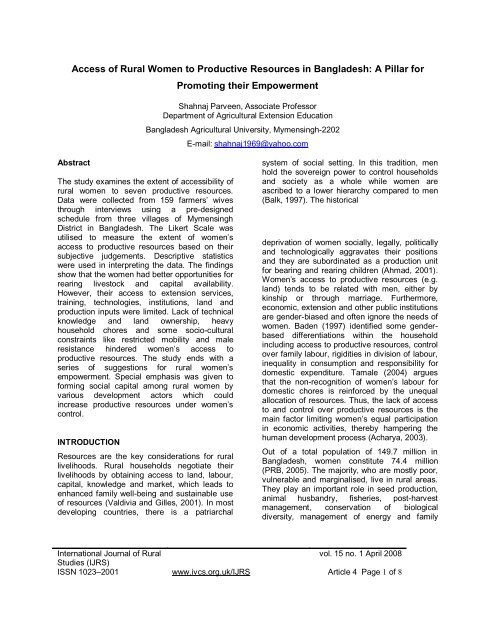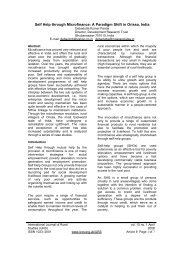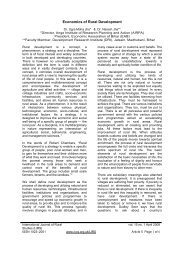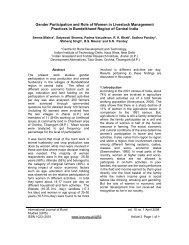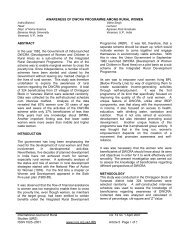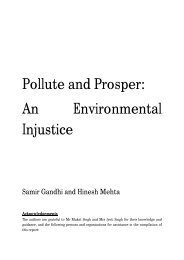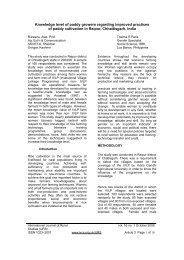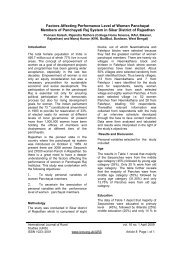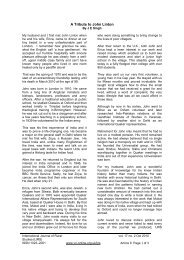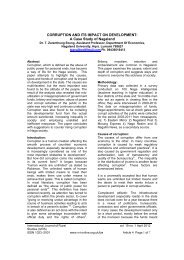4. Access of rural women to productive resources in Bangladesh
4. Access of rural women to productive resources in Bangladesh
4. Access of rural women to productive resources in Bangladesh
Create successful ePaper yourself
Turn your PDF publications into a flip-book with our unique Google optimized e-Paper software.
(Anon., 1995). Despite their tremendouscontribution <strong>to</strong> food production and well-be<strong>in</strong>g forthe household, <strong>rural</strong> <strong>women</strong> are underestimatedand overlooked <strong>in</strong> development strategies.Various socio-cultural and structural barriersaffect their access <strong>to</strong> formal and non-formal<strong>in</strong>stitutions and extension services (Murshid andYasmeen, 2004).It is praiseworthy that the government <strong>of</strong><strong>Bangladesh</strong> has adopted a national policy for theadvancement <strong>of</strong> <strong>women</strong> s<strong>in</strong>ce 1997. Forimprov<strong>in</strong>g the socio-economic condition <strong>of</strong><strong>women</strong>, the efforts <strong>of</strong> different NGOs are alsovery significant. Various development agencieshave undertaken some <strong>in</strong>itiatives andprogrammes focus<strong>in</strong>g on education and skilldevelopment, credit, health and nutrition, politicalempowerment, gender awareness, human rightsand oppression. Some <strong>in</strong>novative steps like freeeducation for girls with special stipends,reservation <strong>of</strong> seats for <strong>women</strong> <strong>in</strong> localgovernment, special quota <strong>in</strong> services andamendment <strong>of</strong> laws have been promot<strong>in</strong>g<strong>women</strong>’s empowerment as well as reduc<strong>in</strong>g thegender disparity. However, <strong>women</strong>’s propertyrights are highly constra<strong>in</strong>ed <strong>in</strong> <strong>Bangladesh</strong>, as itis governed by religious laws. Under the MuslimLaw, a daughter <strong>in</strong>herits one-half the share <strong>of</strong>her brother, a wife receives only one-eighth <strong>of</strong>the deceased husband’s property while a mothergets one-sixth (ADB, 2001; Ramachandran,2006). Due <strong>to</strong> lack <strong>of</strong> land ownership, <strong>women</strong> aregett<strong>in</strong>g <strong>in</strong>adequate attention by manydevelopment agencies. For example, theagricultural extension delivery services <strong>in</strong><strong>Bangladesh</strong> are still concentrated on malefarmers and consequently, fail <strong>to</strong> reach themajority <strong>of</strong> <strong>rural</strong> <strong>women</strong> with modern <strong>in</strong>formationand technologies.<strong>Access</strong> <strong>to</strong> <strong>resources</strong> is one <strong>of</strong> the elements <strong>of</strong><strong>women</strong>’s empowerment and a base for theatta<strong>in</strong>ment <strong>of</strong> the Millennium Development Goals(MDGs). Many <strong>in</strong>ternational conferences havebeen held <strong>to</strong> improve <strong>rural</strong> <strong>women</strong>’s equitableaccess <strong>to</strong> and control <strong>of</strong> land and property <strong>in</strong>recent years. The United Nations has outl<strong>in</strong>edseven <strong>in</strong>terdependent strategic priorities withregard <strong>to</strong> MDG-3 <strong>in</strong> alter<strong>in</strong>g discrim<strong>in</strong>ationaga<strong>in</strong>st <strong>women</strong>. Two strategies are <strong>to</strong> ensure<strong>women</strong>’s property and <strong>in</strong>heritance rights and <strong>to</strong>elim<strong>in</strong>ate gender <strong>in</strong>equality <strong>in</strong> economic sec<strong>to</strong>rs(World Bank, 2007). The 4th World Congress <strong>of</strong>Rural Women, held <strong>in</strong> South Africa <strong>in</strong> 2007,reiterated the need <strong>to</strong> provide full and equalaccess for <strong>rural</strong> <strong>women</strong> <strong>to</strong> <strong>productive</strong> <strong>resources</strong>,<strong>in</strong>clud<strong>in</strong>g the right <strong>to</strong> <strong>in</strong>heritance and ownership<strong>of</strong> land and other property, credit/capital,appropriate technologies, markets and<strong>in</strong>formation. Consider<strong>in</strong>g this complex situation,the researcher attempted <strong>to</strong> exam<strong>in</strong>e some <strong>of</strong>the <strong>productive</strong> <strong>resources</strong> accessible <strong>to</strong> <strong>rural</strong><strong>women</strong> and explore enabl<strong>in</strong>g and limit<strong>in</strong>g fac<strong>to</strong>rs,with the <strong>in</strong>tention <strong>of</strong> mak<strong>in</strong>g them powerfulagents for change over time.THEORETICAL FOCUS<strong>Access</strong> is the right or opportunity <strong>to</strong> use, manageor control a particular resource (Nichols et al.,1999). Resources may be economic (e.g. landand credit), political (e.g. participation <strong>in</strong> localgovernment and community decision-mak<strong>in</strong>g)and social (e.g. education and tra<strong>in</strong><strong>in</strong>g). Ingeneral, <strong>women</strong> and men require different levels<strong>of</strong> access <strong>to</strong> <strong>resources</strong> based on their<strong>productive</strong>, re<strong>productive</strong> and communitymanag<strong>in</strong>g roles (Moser, 1993). Whendisadvantaged <strong>women</strong> have the ability <strong>to</strong> controltheir own environment by ga<strong>in</strong><strong>in</strong>g greater access<strong>to</strong> material and <strong>in</strong>tellectual <strong>resources</strong>,Musokotwane et al. (2001) have called thisprocess ‘empowerment’.Many studies have already found that access <strong>to</strong><strong>productive</strong> <strong>resources</strong> for <strong>women</strong> enhancesknowledge on farm management and <strong>in</strong>comegeneration, develops barga<strong>in</strong><strong>in</strong>g and decisionmak<strong>in</strong>gpower, improves children’s school<strong>in</strong>gand health, <strong>in</strong>creases self-confidence and socialnetworks and provides security <strong>in</strong> old age(IFPRI, 2000; Grace, 2005; Pitt et al., 2006).Poverty alleviation <strong>in</strong> <strong>rural</strong> areas is significantlyrelated <strong>to</strong> <strong>women</strong>’s <strong>in</strong>creased access <strong>to</strong><strong>productive</strong> <strong>resources</strong> (Adereti, 2005). Thus,efforts <strong>to</strong> build social capital among <strong>rural</strong> <strong>women</strong>are necessary for susta<strong>in</strong>able production andhousehold food security through provision <strong>of</strong>facilitat<strong>in</strong>g <strong>resources</strong> (Meludu et al., 1999; Flora,2001). All ac<strong>to</strong>rs <strong>in</strong> development must providethem with support <strong>in</strong> this regard. At the sameInternational Journal <strong>of</strong> Ruralvol. 15 no. 1 April 2008Studies (IJRS)ISSN 1023–2001 www.ivcs.org.uk/IJRS Article 4 Page 2 <strong>of</strong> 8
time, rais<strong>in</strong>g social awareness <strong>of</strong> people aboutthe symp<strong>to</strong>ms, causes and consequences <strong>of</strong>oppressive economic, cultural, familial, religiousand legal practices is necessary for chang<strong>in</strong>gtraditional gender roles and m<strong>in</strong>dsets (Acharya,2003).RESEARCH METHODOLOGYLocation <strong>of</strong> the studyThe study was conducted <strong>in</strong> three villages <strong>of</strong>Mymens<strong>in</strong>gh District <strong>in</strong> <strong>Bangladesh</strong>. Thevillages, namely, Boyra, Sutiakhali andDaribhabakhali were selected purposelyconsider<strong>in</strong>g the location <strong>of</strong> <strong>Bangladesh</strong>Agricultural University, <strong>Bangladesh</strong> Institute <strong>of</strong>Nuclear Agriculture and <strong>Bangladesh</strong> FisheriesResearch Institute, good access <strong>to</strong> governmentand non-government services andcommunication facilities. It was assumed that<strong>rural</strong> <strong>women</strong> had better access <strong>to</strong> various<strong>resources</strong> because <strong>of</strong> the level <strong>of</strong> modernisation<strong>in</strong> these villages.Sampl<strong>in</strong>g designThe population for the study consisted <strong>of</strong> themarried <strong>women</strong> <strong>in</strong> farm households <strong>in</strong> thesethree villages. A representative sample <strong>of</strong> 159was drawn (53 from each village) based onarbitrary allocation (Cochran, 1977). Therespondents were selected from different farmhouseholds by random sampl<strong>in</strong>g.Data collection and analysisThe primary data were collected betweenJanuary and March 2007. In order <strong>to</strong> collectqualitative data, three group discussion sessionswere arranged separately <strong>in</strong> three villages; eachgroup conta<strong>in</strong>ed 10 participants. Dur<strong>in</strong>g thesegroup sessions, several open-ended questionswere asked <strong>of</strong> the respondents <strong>in</strong> order <strong>to</strong> collectdeeper <strong>in</strong>formation about their accessibility <strong>to</strong><strong>resources</strong> along with many hidden facts andfac<strong>to</strong>rs. Based on this <strong>in</strong>formation, the research<strong>in</strong>strument was prepared and a pre-test wasconducted with 18 respondents for its necessarymodification. F<strong>in</strong>ally, <strong>in</strong>terviews were made with159 <strong>rural</strong> <strong>women</strong> <strong>in</strong> a face-<strong>to</strong>-face sett<strong>in</strong>g us<strong>in</strong>gthe pre-designed schedule. The respondentswere requested <strong>to</strong> provide <strong>in</strong>formation abouttheir socio-economic condition, accessibility <strong>of</strong><strong>resources</strong> and constra<strong>in</strong>ts <strong>to</strong> these <strong>resources</strong>.Four key <strong>in</strong>formants (one male and one femalecommunity leader, one extension and one NGOpersonnel) were also <strong>in</strong>terviewed <strong>to</strong> give theirexpert views <strong>in</strong> order <strong>to</strong> formulate strategies for<strong>rural</strong> <strong>women</strong>’s empowerment.Books, journals, reports and <strong>in</strong>ternet documentswere used as secondary sources <strong>of</strong> datasupport<strong>in</strong>g or supplement<strong>in</strong>g the empiricalf<strong>in</strong>d<strong>in</strong>gs <strong>of</strong> the study. Data were analyzed us<strong>in</strong>gthe Statistical Package for the Social Science(SPSS) and some descriptive statistics, such aspercentage, mean, standard deviation (SD),coefficient <strong>of</strong> variation (CV) and rank were used<strong>to</strong> <strong>in</strong>terpret the data.Measur<strong>in</strong>g access <strong>to</strong> <strong>productive</strong> <strong>resources</strong>In this study, access means the ability <strong>of</strong> a <strong>rural</strong>woman <strong>to</strong> get seven socio-economic <strong>resources</strong>and accrue benefits from them. The full mean<strong>in</strong>g<strong>of</strong> these <strong>resources</strong> is illustrated below.• <strong>Access</strong> <strong>to</strong> land: power <strong>to</strong> use familyfarmland, ownership <strong>of</strong> land and controlover it.1. <strong>Access</strong> <strong>to</strong> capital:opportunity <strong>to</strong> get loans, micro-credit andbank<strong>in</strong>g services from any formal or<strong>in</strong>formal <strong>in</strong>stitution.2. <strong>Access</strong> <strong>to</strong> extensionservices and tra<strong>in</strong><strong>in</strong>g: Opportunities <strong>to</strong>develop technical skills for productionthrough tra<strong>in</strong><strong>in</strong>g and obta<strong>in</strong> <strong>in</strong>formationabout development aspects from anyextension agency.• <strong>Access</strong> <strong>to</strong> technologies: availability <strong>of</strong>cost-effective and appropriatetechnologies for production, post-harvestand household tasks. Thesetechnologies <strong>in</strong>cluded improvedvarieties/breeds, artificial <strong>in</strong>sem<strong>in</strong>ation,vacc<strong>in</strong>es, weeders, threshers, sew<strong>in</strong>gmach<strong>in</strong>es and improved s<strong>to</strong>ves.International Journal <strong>of</strong> Ruralvol. 15 no. 1 April 2008Studies (IJRS)ISSN 1023–2001 www.ivcs.org.uk/IJRS Article 4 Page 3 <strong>of</strong> 8
1. <strong>Access</strong> <strong>to</strong> production <strong>in</strong>puts:Availability <strong>of</strong> technological <strong>in</strong>puts suchas quality seeds, sapl<strong>in</strong>gs, fertilizers,pesticides and water supply.2. <strong>Access</strong> <strong>to</strong> lives<strong>to</strong>ck rear<strong>in</strong>g:opportunities <strong>to</strong> rear chickens, ducks,pigeons, cattle and goats for <strong>in</strong>comegeneration.• <strong>Access</strong> <strong>to</strong> <strong>rural</strong> <strong>in</strong>stitutions: Any cooperativesor associations with<strong>in</strong> thelocality provid<strong>in</strong>g production <strong>in</strong>puts,f<strong>in</strong>ancial supports, sav<strong>in</strong>g facilities andother opportunities through <strong>women</strong>’sactive participation.<strong>Access</strong> <strong>of</strong> a <strong>rural</strong> woman <strong>to</strong> <strong>productive</strong> <strong>resources</strong>was measured us<strong>in</strong>g the Likert Scale with aweight <strong>of</strong> 0 represent<strong>in</strong>g ‘no access’, 1 for ‘lowaccess’, 2 for ‘medium access’ and 3 for ‘highaccess’. F<strong>in</strong>ally, a rank order was developedamong the seven <strong>resources</strong> based on meanscore obta<strong>in</strong>ed for each item.RESULTS AND DISCUSSIONPr<strong>of</strong>ile <strong>of</strong> <strong>rural</strong> <strong>women</strong>Analysis <strong>of</strong> the socio-economic condition <strong>of</strong> therespondents found that their mean age was 34years and the length <strong>of</strong> marriage was 18 yearson average. A poor level <strong>of</strong> formal school<strong>in</strong>g(mean: 3.0 years) was found among sampledrespondents, which is one <strong>of</strong> the major causes <strong>of</strong>their <strong>in</strong>ferior status. The <strong>women</strong> had given birth<strong>to</strong> four children on average, perhaps <strong>in</strong>expectation <strong>of</strong> boys for enjoy<strong>in</strong>g a better socialstatus and respect. Most <strong>women</strong> lived <strong>in</strong>households consist<strong>in</strong>g <strong>of</strong> six persons. Theaverage area <strong>of</strong> family farm was 0.70 ha. Themembers <strong>of</strong> the farm household performed bothfarm and non-farm activities and earned anaverage <strong>of</strong> 65000.00 Taka (approximately95<strong>4.</strong>00 US$) annually, which is not enough <strong>to</strong>meet their basic needs.Extent <strong>of</strong> <strong>rural</strong> <strong>women</strong>’s access <strong>to</strong> <strong>resources</strong>Data conta<strong>in</strong>ed <strong>in</strong> Table 1 show that therespondents had better access <strong>to</strong> lives<strong>to</strong>ckrear<strong>in</strong>g (mean: 1.92) and capital availability(mean: 1.42). However, their access <strong>to</strong> extensionservices and tra<strong>in</strong><strong>in</strong>g, technologies, formal or<strong>in</strong>formal <strong>in</strong>stitutions, land and <strong>in</strong>puts forproduction was limited. In support <strong>of</strong> thequalitative data obta<strong>in</strong>ed through groupdiscussions, the extent <strong>of</strong> <strong>women</strong>’s access <strong>to</strong>seven <strong>productive</strong> <strong>resources</strong> and underly<strong>in</strong>g factsare described here on the basis <strong>of</strong> rank order.Table 1: Extent <strong>of</strong> <strong>rural</strong> <strong>women</strong>’s accessibility <strong>to</strong> <strong>productive</strong> <strong>resources</strong> (n = 159)ResourcesExtent <strong>of</strong> access (%)Frequently Occasionally Rarely Not at allMean a(CV)RankorderLives<strong>to</strong>ck rear<strong>in</strong>g 24 45 28 3 1.92 (41) 1Capital 6 42 39 13 1.42 (56) 2Extensionservices andtra<strong>in</strong><strong>in</strong>g15 19 22 44 1.04 (105) 3Rural <strong>in</strong>stitutions 6 18 44 32 0.99 (38) 4Technologies 11 18 25 46 0.93 (110) 5Land 8 11 33 48 0.79 (116) 6Production <strong>in</strong>puts 5 18 10 67 0.62 (156) 7International Journal <strong>of</strong> Ruralvol. 15 no. 1 April 2008Studies (IJRS)ISSN 1023–2001 www.ivcs.org.uk/IJRS Article 4 Page 4 <strong>of</strong> 8
aMean values <strong>of</strong> items rang<strong>in</strong>g from 0 <strong>to</strong> 3, where 0 <strong>in</strong>dicates no access and 3 <strong>in</strong>dicates high access <strong>of</strong><strong>resources</strong>.Figures <strong>in</strong> the parentheses <strong>in</strong>dicate CV = (SD / Mean) × 100.i) <strong>Access</strong> <strong>to</strong> lives<strong>to</strong>ck rear<strong>in</strong>g: almost all therespondents (97%) had the opportunity <strong>to</strong> reardomestic birds and animals. Feed<strong>in</strong>g animalsand poultry birds, clean<strong>in</strong>g their sheds, healthcare and other related activities wereperformed by <strong>women</strong>. They also had a majorrole <strong>in</strong> decision mak<strong>in</strong>g for rear<strong>in</strong>g andmarket<strong>in</strong>g <strong>of</strong> birds, animals and their products.S<strong>in</strong>ce <strong>women</strong> had no access <strong>to</strong> market, sell<strong>in</strong>gand purchas<strong>in</strong>g activities rema<strong>in</strong>ed undermen’s control and hence, <strong>women</strong> weredeprived <strong>of</strong> gett<strong>in</strong>g real benefits from lives<strong>to</strong>ck.The respondents, however, felt that rear<strong>in</strong>gcattle, goats and birds <strong>in</strong>creased household<strong>in</strong>come and their consumption <strong>of</strong> nutritiousfood andii) <strong>Access</strong> <strong>to</strong> capital: The respondents (87%)received a limited amount <strong>of</strong> credit from NGOs(ma<strong>in</strong>ly from BRAC, Grameen Bank and ASA),co-operatives, money lenders and relatives,with a high rate <strong>of</strong> <strong>in</strong>terest. The <strong>women</strong> werealmost always excluded from loans fromcommercial banks because <strong>of</strong> lack <strong>of</strong> landownership. The respondents reported that theiraccess <strong>to</strong> <strong>in</strong>stitutional loans was furtherrestricted by their lack <strong>of</strong> education,conf<strong>in</strong>ement <strong>to</strong> household activities, lack <strong>of</strong>familiarity with loan providers and restrictionson their mobility. Interest<strong>in</strong>gly, a highproportion <strong>of</strong> <strong>women</strong>’s loans was controlled bymale members <strong>of</strong> the household (Goetz andGupta, 1996). In some cases, <strong>women</strong> were noteven allowed <strong>to</strong> <strong>in</strong>vest the loan <strong>in</strong> <strong>in</strong>comegenerat<strong>in</strong>g activities (Husa<strong>in</strong> and Mallik, 1998).iii) <strong>Access</strong> <strong>to</strong> extension services and tra<strong>in</strong><strong>in</strong>g:almost half respondents (44%) had noopportunity <strong>to</strong> receive services from differentextension agencies like the Department <strong>of</strong>Agricultural Extension (DAE) and theDepartment <strong>of</strong> Lives<strong>to</strong>ck Services (DLS). Theyreported that hav<strong>in</strong>g access <strong>to</strong> such servicesfor <strong>women</strong> largely depended on theirhusbands, s<strong>in</strong>ce extension services are mostlydirected <strong>to</strong>wards male farmers and femaleextension agents are very limited <strong>in</strong> numbers.As a result, they lack modern avenues <strong>of</strong>knowledge and <strong>in</strong>formation, new technologiesand opportunities for tra<strong>in</strong><strong>in</strong>g <strong>to</strong> <strong>in</strong>crease theirfarm productivity and <strong>in</strong>come.iv) <strong>Access</strong> <strong>to</strong> <strong>rural</strong> <strong>in</strong>stitutions: 68% <strong>of</strong>respondents were <strong>in</strong>volved <strong>in</strong> co-operatives or<strong>in</strong>formal associations, which createdopportunities for sav<strong>in</strong>gs, tak<strong>in</strong>g loans,discussions and participation <strong>of</strong> <strong>women</strong> <strong>in</strong>social events like agricultural fairs.v) <strong>Access</strong> <strong>to</strong> technologies: Table 1 shows thatnearly half respondents (46%) had no access<strong>to</strong> modern technologies. They used traditional<strong>to</strong>ols and practices for production andhousehold purposes. Due <strong>to</strong> lack <strong>of</strong> capital, itwas difficult for <strong>women</strong> <strong>to</strong> hire or buy or adopttechnologies like threshers, sew<strong>in</strong>g mach<strong>in</strong>esand artificial <strong>in</strong>sem<strong>in</strong>ation. Moreover, theylimited their labour time <strong>in</strong> economic activitiesdue <strong>to</strong> heavy commitment <strong>to</strong> domestic chores.They stated that technologies had not yet beendesigned for <strong>women</strong>’s tasks and had littleimpact on the welfare <strong>of</strong> <strong>rural</strong> <strong>women</strong>.vi) <strong>Access</strong> <strong>to</strong> land: about half <strong>of</strong> the <strong>women</strong>(48%) were deprived <strong>of</strong> access <strong>to</strong> land, whichled <strong>to</strong> serious constra<strong>in</strong>ts on gett<strong>in</strong>g credit and<strong>in</strong>creas<strong>in</strong>g their <strong>productive</strong> capacity. Therespondents could only use land <strong>in</strong> and aroundtheir homesteads for garden<strong>in</strong>g. Lack <strong>of</strong>education and tra<strong>in</strong><strong>in</strong>g, fewer opportunities foremployment, cultural taboos, male resistanceand f<strong>in</strong>ancial constra<strong>in</strong>ts were the obstacless<strong>to</strong>pp<strong>in</strong>g the respondents from <strong>in</strong>herit<strong>in</strong>g, us<strong>in</strong>gand secur<strong>in</strong>g land. Moreover, they were notwell equipped <strong>to</strong> deal with tenants, sale <strong>of</strong>produce or reach the land located at a distantplace.vii) <strong>Access</strong> <strong>to</strong> production <strong>in</strong>puts: unexpectedly,only 33% <strong>of</strong> respondents had little access <strong>to</strong>important <strong>in</strong>puts (e.g. seed and sapl<strong>in</strong>gs) forInternational Journal <strong>of</strong> Ruralvol. 15 no. 1 April 2008Studies (IJRS)ISSN 1023–2001 www.ivcs.org.uk/IJRS Article 4 Page 5 <strong>of</strong> 8
production purposes. S<strong>in</strong>ce they had no land, itwas not easy <strong>to</strong> ga<strong>in</strong> access <strong>to</strong> <strong>in</strong>puts likefertilizers and pesticides.Views <strong>of</strong> key <strong>in</strong>formantsThe key <strong>in</strong>formants selected for the studyprovided a wealth <strong>of</strong> <strong>in</strong>formation about theirroles and limitations, current socio-economicatmosphere, social stigmatization and servicesavailable <strong>to</strong> <strong>women</strong>’s welfare <strong>in</strong> the locality.They made the follow<strong>in</strong>g suggestions forimprov<strong>in</strong>g <strong>women</strong>’s access <strong>to</strong> <strong>productive</strong><strong>resources</strong> as well as their status <strong>in</strong> the <strong>rural</strong>community:• Enhanc<strong>in</strong>g <strong>rural</strong> <strong>women</strong>’s <strong>in</strong>comegenerat<strong>in</strong>g activities by provid<strong>in</strong>gliteracy, technical <strong>in</strong>formation andskills, <strong>in</strong>puts and credit (<strong>in</strong> k<strong>in</strong>d orcash) for agricultural and nonagriculturalproduction.• Transferr<strong>in</strong>g cost-effective and suitabletechnologies for <strong>women</strong> throughextension agencies.• Establish<strong>in</strong>g formal and non-formal<strong>in</strong>stitutions for technical assistanceand capacity build<strong>in</strong>g for <strong>women</strong>.• Ensur<strong>in</strong>g <strong>women</strong>’s participation <strong>in</strong> <strong>rural</strong>development schemes and communitydecision-mak<strong>in</strong>g.• Ensur<strong>in</strong>g <strong>women</strong>’s rights <strong>to</strong> land andproperty by the government <strong>in</strong>clud<strong>in</strong>glocal authorities.• Implement<strong>in</strong>g awareness rais<strong>in</strong>gprogrammes on different aspects <strong>of</strong>gender at the village level.CONCLUSIONSFrom the f<strong>in</strong>d<strong>in</strong>gs, discussions andsuggestions mentioned earlier, it is crucial fordevelopment ac<strong>to</strong>rs <strong>to</strong> address the issue <strong>of</strong><strong>rural</strong> <strong>women</strong> <strong>in</strong> a comprehensive and holisticmanner. In particular, allocation <strong>of</strong> <strong>resources</strong>related <strong>to</strong> the practical and strategic <strong>in</strong>terests<strong>of</strong> <strong>rural</strong> <strong>women</strong> should be <strong>in</strong>tegrated <strong>in</strong><strong>to</strong> <strong>rural</strong>development policies and programmes.Education, tra<strong>in</strong><strong>in</strong>g and capacity build<strong>in</strong>g arenecessary pre-requisites for empower<strong>in</strong>g <strong>rural</strong><strong>women</strong> <strong>in</strong> the study area. Donors, NGOs and<strong>women</strong>’s organizations, <strong>in</strong> addition <strong>to</strong>government organisations, should comeforward <strong>to</strong> take this <strong>in</strong>itiative for susta<strong>in</strong>ed <strong>rural</strong>development.REFERENCESAcharya, M. (2003) Efforts at Promotion <strong>of</strong> Women <strong>in</strong>Nepal. Kathmandu: Tanka Prasad AcharyaFoundation.ADB (2001) Women <strong>in</strong> <strong>Bangladesh</strong>: The Country Brief<strong>in</strong>gPaper. Manila: Asian Development Bank.Adereti, F.O. (2005) Rural Women’s <strong>Access</strong> <strong>to</strong> and ControlOver Productive Resources: Implications forPoverty Alleviation Among Osun-State RuralWomen, Nigeria. Journal <strong>of</strong> Human Ecology, 18(3): 225-230.Ahmad, F. (2001) Gender Division <strong>of</strong> Labour: <strong>Bangladesh</strong>Context. Steps Towards Development, 6 (1): 7-26.Anon. (1995) Environmental Education Tra<strong>in</strong><strong>in</strong>g Module <strong>in</strong>Agriculture. Graduate Tra<strong>in</strong><strong>in</strong>g Institute,<strong>Bangladesh</strong> Agricultural University and Foodand Agriculture Organisation.Baden, S. (1997) Gender Inequality and Poverty: Trends,L<strong>in</strong>kages, Analysis and Policy Implications.BRIDGE (development - gender), Institute <strong>of</strong>Development Studies, University <strong>of</strong> Sussex, UK.Balk, D. (1997) Change Comes Slowly for Women <strong>in</strong> Rural<strong>Bangladesh</strong>. Asia-Pacific Population & Policy,41: <strong>4.</strong>Cochran, W.G. (1977) Sampl<strong>in</strong>g Techniques (3 rd edn.).New York: John Wiley & Sons, Inc.Flora, C.B. (2001) <strong>Access</strong> and Control <strong>of</strong> Resources:Lessons from the SANREM-CRSP. Agricultureand Human Value, 18 (1): 41-48.Goetz, A.M. and Gupta, R.S. (1996) Who Takes theCredit? Gender, Power and Control over LoanInternational Journal <strong>of</strong> Ruralvol. 15 no. 1 April 2008Studies (IJRS)ISSN 1023–2001 www.ivcs.org.uk/IJRS Article 4 Page 6 <strong>of</strong> 8
Use <strong>in</strong> Rural Credit Programs <strong>in</strong> <strong>Bangladesh</strong>.World Development, 24 (1): 45-63.Grace, J. (2005) Who Owns the Farm? Rural Women’s<strong>Access</strong> <strong>to</strong> Land and Lives<strong>to</strong>ck. Kabul:Afghanistan Research and Evaluation Unit(AREU).Husa<strong>in</strong>, A.M.M. and Mallick, D. (1998) Conclusion andPolicy Implications, pp. 173-183, <strong>in</strong>: A.M.M.Husa<strong>in</strong> (ed.) Poverty Alleviation andEmpowerment. Research and EvaluationDivision, BRAC Centre, Dhaka.IFPRI (2000) Resource Allocation and Empowerment <strong>of</strong>Women <strong>in</strong> Rural <strong>Bangladesh</strong>. International FoodPolicy Research Institute, Wash<strong>in</strong>g<strong>to</strong>n, DC.Meludu, N.T.; Ifie, P.A.; Ak<strong>in</strong>bile, L.A. and Adekoya, E.A.(1999) The Role <strong>of</strong> Women <strong>in</strong> Susta<strong>in</strong>able FoodSecurity <strong>in</strong> Nigeria: A Case <strong>of</strong> Udu LocalGovernment Area <strong>of</strong> Delta State. Journal <strong>of</strong>Susta<strong>in</strong>able Agriculture, 15 (1): 87 - 97.Moser, C. (1993) Gender Plann<strong>in</strong>g and Development:Theory, Practice and Tra<strong>in</strong><strong>in</strong>g. New York:Routledge.Murshid, S. and Yasmeen, A. (2004) Women <strong>of</strong> the Coast.Gender status paper, Program DevelopmentOffice for Integrated Coastal Zone ManagementPlan, Dhaka.Musokotwane, R., R.M. Siwale, and B. Nkhata (2001)Gender Awareness and Sensitization <strong>in</strong> BasicEducation. Paris: People’s Action ForumUNESCO Basic Education Division.Nichols, S.; Crowley, E. and Komjathy, K. (1999) Women’s<strong>Access</strong> <strong>to</strong> Land: Surveyors can Make aDifference. Survey Quarterly, 20: 16-19.Pitt, M.M.; Khandker, S.R. and Cartwright, J. (2006)Empower<strong>in</strong>g Women with Micro F<strong>in</strong>ance:Evidence from <strong>Bangladesh</strong>. EconomicDevelopment and Cultural Change, 54 (4): 791–831.PRB (2005) Women <strong>of</strong> Our World. Population ReferenceBureau, Wash<strong>in</strong>g<strong>to</strong>n, DC. Available athttp://www.prb.org/pdf05/WomenOfOurWorld2005.pdf (searched date: 12 August 2007).Ramachandran, N. (2006) Women and Food Security <strong>in</strong>South Asia: Current Issues and Emerg<strong>in</strong>gConcerns. Research Paper No. 2006/131,UNICEF, New Delhi.Tamale, S. (2004) Gender Trauma <strong>in</strong> Africa: Enhanc<strong>in</strong>gWomen’s L<strong>in</strong>ks <strong>to</strong> Resources. Journal <strong>of</strong> AfricanLaw, 48 (1): 50-61.Valdivia, C. and Gilles, J. (2001) Gender and ResourceManagement: Households and Groups,Strategies and Transitions. Agriculture andHuman Value, 18 (1): 5-9.World Bank (2007) Global Moni<strong>to</strong>r<strong>in</strong>g Report 2007:Millennium Development Goals - Confront<strong>in</strong>g theChallenges <strong>of</strong> Gender Equality and FragileStates. Wash<strong>in</strong>g<strong>to</strong>n, DC: The International Bankfor Reconstruction and Development/The WorldBank.International Journal <strong>of</strong> Ruralvol. 15 no. 1 April 2008Studies (IJRS)ISSN 1023–2001 www.ivcs.org.uk/IJRS Article 4 Page 7 <strong>of</strong> 8
International Journal <strong>of</strong> Ruralvol. 15 no. 1 April 2008Studies (IJRS)ISSN 1023–2001 www.ivcs.org.uk/IJRS Article 1 Page 8 <strong>of</strong> 8


